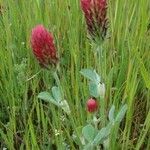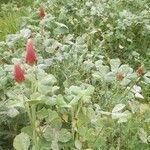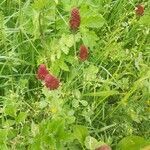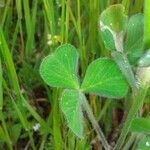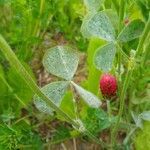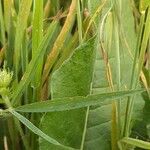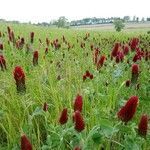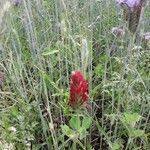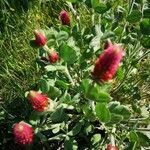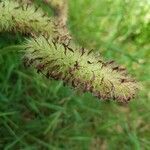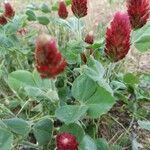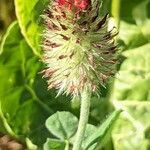Annual herbs, pubescent. Stems erect or ascending, 30-100 cm, simple to sparingly branched, striate. Leaves palmately 3-foliolate, long petiolate in lower leaves, shortly petiolate in upper leaves; stipules dark green to purple, elliptic, connate and adnate to petiole for ca. 3/4 their length, membranous, veins 3-5, base sheathing, apex broadly triangular or rounded; leaflets broadly obovate to suborbicular, 1.5-3.5 cm, lateral veins 5-10, base cuneate, margins irregularly crenate, apex retuse to obtuse. Flowers 50-80(-120), in dense, cylindric, terminal heads, 3-6 × 1-1.5 cm; peduncle 2.5-7 cm, stout. Calyx densely hirsute, veins 10; teeth subulate, longer than or equal to tube. Corolla red, pink, or white, 10-15 mm; standard narrowly elliptic, acute. Ovary oblate. Legume ovoid. Seed 1, greenish brown, ovoid. Fl. and fr. May-Jul.
Annual, 3–8 dm, the stem appressed-hairy; stipules blunt, ± erose and usually red or purple around the summit; lfls broadly obovate, tapering to the base, broadly rounded or truncate above; heads ovoid or cylindric, 3–5 cm, on long, erect peduncles; fls 10–15 mm; cal-tube densely villous, 3 mm, the linear-subulate lobes subequal, 5–7 mm; cor crimson, straight, the standard oblanceolate, obtuse; 2n=14. Native of Europe, found in old fields, waste places, and roadsides as an escape from cult. May–Aug.
An annual herb. It is an erect plant. The stems are hairy. The leaves are divided into 3 leaflets. The leaflets are also hairy. The leaflets have teeth near their ends and can vary in shape. The leafy structure at the base of the leaf (stipule) is round and wavy. The flowers are small. They are in oblong heads. These occur singly at the ends of stalks. The flowers are dark red.
